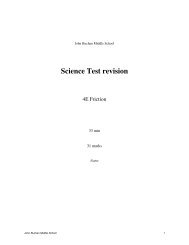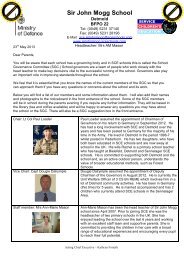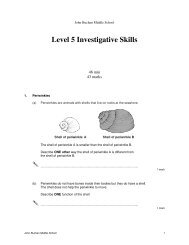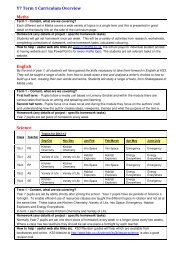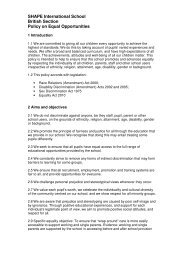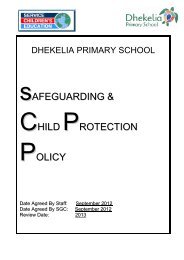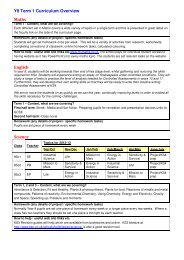Questions - John Buchan School
Questions - John Buchan School
Questions - John Buchan School
Create successful ePaper yourself
Turn your PDF publications into a flip-book with our unique Google optimized e-Paper software.
Level 41. Brine shrimps and flamingoes(a)A brine shrimp is a tiny living thing. It lives in lakes and eats algae(green plants).Brine shrimpFlamingoes eat brine shrimps. They filter the shrimps from the water.Look at the picture of the flamingo.Describe one feature of the flamingo’s neck that helps the flamingo to feed......................................................................................................................1 mark(b)Write the food chain for the three living things described above.1 mark<strong>John</strong> <strong>Buchan</strong> Middle <strong>School</strong> 2
(c)The lakes dry up in hot weather and fill up again when it rains.When the lake is dry the adult brine shrimps die, but the eggs do not.Explain why it is important to the life cycle of brine shrimps that the eggs donot die when the lake dries up...........................................................................................................................................................................................................................................1 mark2. Nature walk(a)Some children draw a food chain about living things they see in the garden.There is a mistake in their food chain.What is the mistake in their food chain?............................................................................................................................................................................................................................................1 mark(b)The children correct their food chain. They make a table showing if each animal inthe food chain is a predator, prey or both.Tick ONE box in each row of the table to show whether each animal in the foodchain is a predator, prey or both.Animal Predator Prey Bothcaterpillarbirdcat2 marks<strong>John</strong> <strong>Buchan</strong> Middle <strong>School</strong> 3
(c)Which word best describes the function of the cabbage in the food chain?Tick ONE box.fertiliserconsumerorganismproducer41 mark(d)The children make a table about some other animals they found.AnimalWhere theyfound itNumberof legsNumberof wingsmayfly near the pond 6 4spider in the grass 8 0female glow-worm in the grass 6 0duck near the pond 2 2They use their table to make a key.<strong>John</strong> <strong>Buchan</strong> Middle <strong>School</strong> 4
(i)(ii)Use the table above to help you write in the missing question onthe key below.Write the name of each animal from the table in the correct boxon the key below.One has been done for you.Question:Does it have six legs?YesNoQuestion:Does it have wings?Question:.......................................................................................YesNoYesNo.............................. .............................. spider ..............................2 marks<strong>John</strong> <strong>Buchan</strong> Middle <strong>School</strong> 5
3. Brine shrimps(a)Joanne is watching 5 brine shrimps in a container.She has covered the container to make one half dark and one half light.How many brine shrimps were in the dark after 30 seconds?.................................................1 mark(b)Amy and Rebecca planned to investigate whether brine shrimps prefer toswim in the light or the dark.Step 1Step 2Step 3Step 4Amy’s PlanPut 1 shrimp in one dish.Watch the dish for5 minutes.Record the amount oftime the shrimp wasin the light.Compare the amount oftime the shrimp spent inthe light with the timespent in the dark.Rebecca’s PlanPut 10 shrimps in one dish.Watch the dish for 1 minute.Count how many shrimpswere in the light every 10seconds.Compare the number ofshrimps seen in the lightwith the number out ofsight in the dark.<strong>John</strong> <strong>Buchan</strong> Middle <strong>School</strong> 6
Look at Amy’s plan.What measurements should Amy compare to decide whether shrimpsprefer light or dark?............................................................................................................................................................................................................................................1 mark(c)Look at Rebecca’s plan.How did Rebecca work out how many brine shrimps were in the dark each timeshe looked?............................................................................................................................................................................................................................................1 mark(d)Look at Amy’s and Rebecca’s plans.(i)Which do you think is the better science plan?Tick ONE box.Amy’sRebecca’s(ii)Explain why.....................................................................................................................................................................................................................................................................................................................................1 mark<strong>John</strong> <strong>Buchan</strong> Middle <strong>School</strong> 7
4. Butterfly garden(a)This diagram shows the life cycle of a red admiral butterfly.<strong>John</strong> wants to get rid of all the nettles in the school wildlife area.This will affect the red admiral butterfly.Give TWO different reasons why nettle plants are important in the life cycle ofthe red admiral butterfly.(i) ............................................................................................................(ii) ............................................................................................................1 mark1 mark(b)Some birds eat caterpillars.Use the diagram to help you complete the food chain below........................... ............................ bird .........81 mark<strong>John</strong> <strong>Buchan</strong> Middle <strong>School</strong> 8
5. Vegetable Patch(a)Kami sees all of the things below while he is working in his vegetable patch.Tick FIVE boxes to show which of these things are living.2 marks<strong>John</strong> <strong>Buchan</strong> Middle <strong>School</strong> 9
(b)Kami grows cabbages in his vegetable patch. Some of the cabbagesare eaten by snails. Some of the snails are eaten by birds called thrushes.Write a food chain to show this information.Use arrows in your food chain............................... .............................. ..............................2 marks(c)A cabbage has many leaves.Tick ONE box to show why leaves are important to a cabbage plant.The leaves...attract insects.collect pollen.anchor the plant inthe ground.produce newmaterial for growth.1 mark(d)Kami cuts a cabbage in half. The leaves on the outside of the cabbage are dark.The leaves on the inside are a pale yellow colour.Which statement best explains why the leaves on the inside are paler?Tick ONE box.The leaves on the inside of the cabbage get...less light.less water.more minerals.more air.1 mark<strong>John</strong> <strong>Buchan</strong> Middle <strong>School</strong> 10
6. Animals in their environment(a)Draw THREE lines to match each of these animals to the environment in which itlives.1 mark(b)Highland cows look different from other types of cow.Look at the pictures of the cows.How are Highland cows better protected against cold weather than Jersey cows?......................................................................................................................1 mark<strong>John</strong> <strong>Buchan</strong> Middle <strong>School</strong> 11
(c)These animals live in different environments.Complete the table below to describe ONE feature of a Polar Bear. Say howthe feature helps the Polar Bear to live in its environment.Animal Lives in... One feature that helpsthe animal to live inHow thefeature helpsits environmentMonkey rainforest it has a tail to help it balancePolarBearthe Arctic it has ....................................................................................................................1 mark<strong>John</strong> <strong>Buchan</strong> Middle <strong>School</strong> 12
Level 57. Periwinkles(a)Periwinkles are animals with shells that live on rocks at the seashore.Shell of periwinkle AShell of periwinkle BThe shell of periwinkle A is smaller than the shell of periwinkle B.Describe ONE other way the shell of periwinkle A is different fromthe shell of periwinkle B...............................................................................................................1 mark(b)Periwinkles do not have bones inside their bodies but they do have a shell.The shell does not help the periwinkle to move.Describe ONE function of the shell...............................................................................................................1 mark(c)A scientist wants to find out if the area the periwinkles live in affects the size oftheir shells. He measures a sample of 20 periwinkle shells from two differentareas of the seashore.Why does he measures 20 periwinkle shells from each area instead of just oneperiwinkle?............................................................................................................................................................................................................................1 mark<strong>John</strong> <strong>Buchan</strong> Middle <strong>School</strong> 13
(d)Explain why it is important to return the animals to the same place they werecollected from.............................................................................................................................................................................................................................1 mark(e)The scientist measures how much water is in a rockpool. After five hours thewater level in the rockpool is lower. No waves splashed into the rockpool duringthis time. No water could leak out.Rockpool Rockpool after 5 hoursDescribe what happened to the water in the rockpool during the five hours...............................................................................................................1 mark<strong>John</strong> <strong>Buchan</strong> Middle <strong>School</strong> 14
8. Edward Jenner(a)Edward Jenner was a doctor who lived a long time ago.Jenner noticed that people who suffered from a disease called cowpox did notcatch smallpox.Smallpox is a disease that can kill people.Picture of Edward Jenner from Senior Biology (1991),King, R.J. and Sullivan, F.M. Pearson Education, Australia.What do we call it when someone notices something important like this?Tick ONE box.an observationan effectan investigationa measurement1 mark(b)Jenner carried out a test. He used cowpox to see if it could stop people catchingsmallpox. He carried out his test on several people.Why did Jenner carry out his test on several people instead of on just oneperson?............................................................................................................................................................................................................................................1 mark<strong>John</strong> <strong>Buchan</strong> Middle <strong>School</strong> 15
(c)A micro-organism causes smallpox.Why do scientists wear masks and gloves when they work with micro-organisms?......................................................................................................................71 mark(d)There are many types of micro-organism. Some can help to prevent or curedisease.Describe ONE different way in which micro-organisms can be helpful.......................................................................................................................1 mark(e)The diagrams below show how three different micro-organisms look under amicroscope.A B C<strong>John</strong> <strong>Buchan</strong> Middle <strong>School</strong> 16
Use the key below to help you identify these micro-organisms.Write your answers under the key.Does it have a nucleus?yesnoDoes it have a tail?Is it covered in hairs?yesnoyesnoEuglena Amoeba BacteriumBlue-greenalgaeA is ................................................. B is .................................................C is .................................................2 marks9. Woodland survey(a)Sam and Peter measure around the trunks of ten oak trees.They measure five trees growing close together and five trees growing in openspace. The trees are all the same age.Here are their results.sizes of treetrunks closetogether (cm)sizes of treetrunks in openspace (cm)101 31867 19080 32032 40096 350<strong>John</strong> <strong>Buchan</strong> Middle <strong>School</strong> 17
The range of measurements for tree trunks growing close together was32–101 cm.What was the range of measurements for tree trunks growing in open space?................................................ cm1 mark(b)Use the information in the tables. Compare the size of tree trunks growing closetogether with the size of tree trunks growing in open space.............................................................................................................................................................................................................................................1 mark(c)Trees need light to help them grow.How do trees use light to help them grow?............................................................................................................................................................................................................................................1 mark(d)Name TWO other things that trees need to take in to help them grow.Light and .......................................... and .............................................2 marks<strong>John</strong> <strong>Buchan</strong> Middle <strong>School</strong> 18
(e)Peter finds lots of fungi under a tree.Write true or false next to each sentence about fungi below.One has been done for you.Fungi are living things. .............................. trueFungi can grow. ..............................Fungi can reproduce. ..............................1 mark10. Hedgehogs<strong>John</strong> <strong>Buchan</strong> Middle <strong>School</strong> 19
(a)Look at the picture.Which part of the hedgehog’s body helps stop foxes from eating it?......................................................................................................................1 mark(b)The bush makes food material in its leaves.The hedgehog’s food includes slugs.The two sentences above describe the same life process.Which life process?Tick ONE box.growthmovementexcretionnutritionsensingnone of these81 mark<strong>John</strong> <strong>Buchan</strong> Middle <strong>School</strong> 20
(c)The hedgehog gives birth to young. This shows that it reproduces.Which of the following shows that the bush also reproduces?Tick ONE box.New leaves grow in spring.Leaf buds open in spring.Leaves fall in autumn.Seeds are dispersed in autumn.1 mark(d)This graph shows how the mass of a female hedgehog changes in one year.Graph showing change in mass of female hedgehog900800Mass(g)700600500Jan Feb Mar Apr May Jun Jul Aug Sept Oct Nov DecTime (months)<strong>John</strong> <strong>Buchan</strong> Middle <strong>School</strong> 21
Look at the graph. It shows that the hedgehog lost weight when shehibernated (slept) through the winter.It also shows when she gave birth.In which month does the graph show that the hedgehog gave birth?......................................................................................................................1 mark<strong>John</strong> <strong>Buchan</strong> Middle <strong>School</strong> 22



